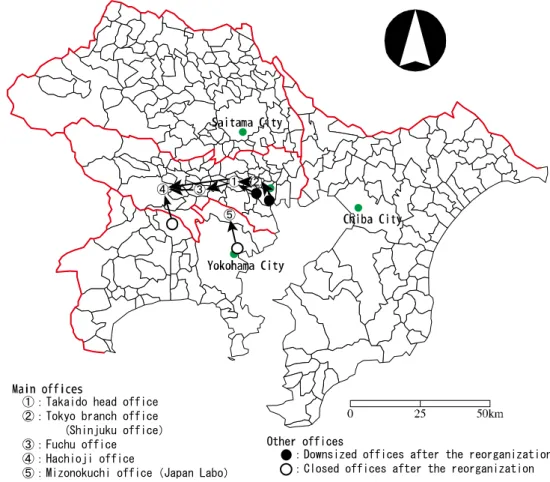THE TRANSFORMATION OF LOCATION AND OFFICE FORM OF A FOREIGN-BASE JAPANESE IT COMPANY
IN TOKYO METROPOLITAN AREA
Hiroyuki TSUBOMOTO
Abstract : This research examined the case with the office construction of the enterprise that advanced the business reform corresponding to informationization and the internationalization. After 1990s, a foreign-base Japanese IT company advanced the office decentralization of the metropolitan area based on the cost reduction. It was considered that the location in the center of the metropolis was important in the latter half of 1990s, and the center office was constructed as non-teritorial office that has not install desks allocated employee one by one. The introduction of wide software was indispensable for the new office with hardware.
Key words: Informationization, Foreign based IT company, Locational reorganization, Free address office, Tokyo metropolitan area
1. Importance of consideration of office form
The development of IT: information technology is estimated to give a significant impact on the geographical location and thus the development of sub-urban offices is forecasted, base on the context of decreased significance on the face-to-face contact in business.
Aritome and Ishikawa (2003) who introduced the launch of satellite office by information communication company in western suburb of Tokyo, is an example that worked on a new office style.
However, their study does not consider the key characteristics of the management side. And the appearance of new office style does not simply mean the adaptation and utilization of new IT. The conventional studies lack the comprehensive understanding of the pilot process for new style offices.
The diversified approach would be the key to study on the offices.
Based on the background, this study focuses on the company which deal with IT, which holds the
key to balance the office function and the necessity for face-to-face contact.
2. The spatial reorganization of a foreign-base Japanese IT company
Hewlett-Packard Japan (HPJ), the Japanese entity of Hewlett-Packard, suffered from the increasing amount of locational cost in the early 1990s, and was instructed by their headquarter to cut down on their management budget by 25%. In order to maintain the labor cost, HPJ decided to cut down on their locational cost, and looked for the suitable place for relocating their office. In 1991, the “Metropolitan Master Plan (Shutoken Master Plan)”, the plan to segment the offices depending on the distance from the center of Tokyo, was developed (Fig.1).
HPJ segmented Tokyo metropolitan area into 3 rings, depending on the distance from the center of Tokyo to use as a benchmark for office reorganization. The first ring with the diameter of 5-10 km was limited to financial companies and sales offices for distribution industries who conduct services directly to customers, and such functions were concentrated to their rented offices in Shinjuku. Other sales offices were reformed for other purposes such as showrooms, and the office space in center of Tokyo was cut down. The sales staffs on the manufacturing side relocated their offices to the second
First ring office:②,Second ring:① and ⑤,Third ring:③ and ④ The arrows show the move of the function between each office.
③ ① ②
④
⑤
①:Takaido head office
②:Tokyo branch office (Shinjuku office)
③:Fuchu office
④:Hachioji office
⑤:Mizonokuchi office(Japan Labo)
Other offices
:Downsized offices after the reorganization
:Closed offices after the reorganization

